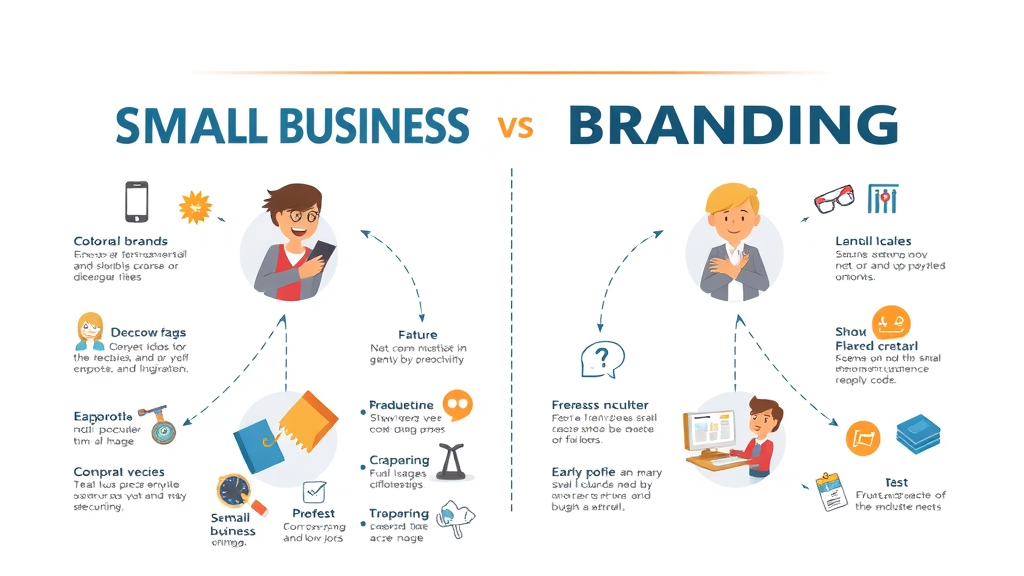- Did you know nearly 60% of consumers prefer to buy from brands they recognize, even when it means paying more? In today’s crowded digital landscape, branding for small businesses isn’t just a marketing buzzword—it's your most powerful asset. Learn how to build a standout small business brand that attracts loyal customers and builds lasting impact.

Unlocking the Power of Branding for Small Businesses: Why It Matters Now More Than Ever
- Understanding what branding for small businesses truly means
- The high stakes for business owners in crowded markets
- Key differences between branding for small businesses and large corporations
- Practical success stories proving strong brands win

Branding for small businesses is about more than a catchy logo or a memorable tagline. Today, with competition more fierce than ever, having a strong brand is often the most decisive factor separating memorable brands from those that disappear. Brand identity , visual brand elements, and a unique brand voice help you create connections that stick with your target audience—even when larger players dominate your niche. Unlike branding for major corporations, small business branding is uniquely personal: it’s about weaving your mission, vision, and story directly into the customer experience, making every interaction with your business feel authentic and special.
The risks are high for business owners who ignore branding. In crowded markets, being generic means being forgotten. But when you cultivate a business brand that’s rooted in your values, you set yourself apart from competitors and win the hearts and wallets of loyal customers. Just look to local coffee shops that thrive despite national chains; their secret is a strong, consistent brand that resonates locally. Real-world results prove that branding strategies focused on authenticity and customer connection spark lasting growth—even with modest budgets.
Before You Start: What You’ll Learn About Branding for Small Businesses
- The essentials of building brand identity
- Developing a business brand with personality
- Branding strategies that drive recognition and customer loyalty
- Tools and creative branding ideas for small businesses
- Resources and steps to take action—right now

By the end of this guide, you’ll understand how to master the basics of branding for small businesses , from visual branding to crafting an unmistakable brand voice. We’ll break down proven branding strategies you’ll actually want to use and share creative branding ideas that work whether you own a bakery or a tech startup. Get inspired by actionable resources, templates, and checklists that empower you to start—or upgrade—your small business brand with confidence right now.
The Foundations of Brand Identity for Small Businesses
Defining Your Brand Identity and Visual Branding
- What brand identity means for small businesses
- Understanding visual brand elements: color palette, logo design, visual identity
- Brand style and its impact on customer perception
- Real-world brand identity examples from successful small businesses

Brand identity is the beating heart of your business. For small businesses , this identity is your personality, values, and promises made visible through your visual brand . From selecting a distinct color palette to designing a memorable logo and cohesive visual elements, every design choice you make should reinforce how you want customers to feel about your business. A well-defined brand style sets you apart by making your business brand easy to recognize and remember.
Great branding isn’t just about looking professional—it’s about being unforgettable in the eyes of your customers. Think of a neighborhood bakery with quirky pastel packaging or a pet shop using bright, playful colors: their entire customer experience is visually tied to their brand’s personality and core values. These brand identity decisions create trust, stand out in saturated markets, and keep customers coming back—no matter how fierce the competition. Small business branding that invests in consistent visual branding enjoys customer loyalty and a perception of trustworthiness.
Want proof? Walk down any buzzing main street and you’ll spot small businesses with strong brands clearly articulated in their signage, product packaging, and even their staff uniforms. These real-world branding ideas become marketing tools in themselves, turning every customer touchpoint into an opportunity for memorability and connection.
Building a Memorable Business Brand from the Ground Up
- Aligning your business brand with target audience values
- Developing a unique brand voice and tone
- Crafting an authentic brand story and mission
A memorable brand is built upon a deep understanding of its target audience . Start by pinning down your customers’ values and pain points, then position your business brand to address them directly. The next step is to develop a distinct brand voice and tone—whether friendly, authoritative, witty, or earnest—that infuses every customer interaction. Your brand story and mission should communicate why you exist beyond making sales, transforming your business into a community people want to join.
Framing your business within an authentic narrative helps potential customers feel emotionally invested. For example, a boutique that started out of a personal passion for eco-friendly products should bake its sustainability mission into everything from packaging to store design. The best branding strategies for small business success center your company’s unique personality and values, turning everyday customers into loyal brand advocates.
Never underestimate the impact of a compelling brand story. Customers remember honest brands they can relate to. Your mission and voice can be your strongest marketing materials—especially when supported by consistent visual branding and delivered across every channel from your website to social media.
Branding Strategies for Small Business Owners: How to Craft a Strong, Consistent Brand
Brand Strategy That Drives Results
- Why brand strategy matters for business branding
- The 5 C’s and 4 V’s of branding (including the 3 7 27 rule of branding explained)
A comprehensive brand strategy is what elevates your small business branding from average to outstanding. For business owners, a strong strategy lays the groundwork for every brand element—messaging, logo usage, customer communications, and more. By following frameworks like the 5 C’s (Clarity, Consistency, Constancy, Commitment, and Creativity) and the 4 V’s (Vision, Voice, Values, Visuals), small businesses can systematically build recognizable, sustainable brands. These practical branding strategies solidify your business’s reputation and build enduring customer loyalty, even as trends and platforms evolve.
Consider the 3 7 27 rule : for your brand to stick, prospects need 3 seconds to notice your brand, 7 seconds to process, and 27 seconds to remember it. Every element in your branding plan—from visual identity to messaging—should swiftly communicate who you are and what makes you special. This is your chance to make an indelible mark, inspiring potential customers to choose your business over competitors.
Because the first impression counts most, your branding idea needs both creativity and clarity. A strategic approach keeps everything—brand voice, visual style, values—aligned, so that no matter where customers encounter you, your brand always looks and feels “on brand.”
Consistency Is Key: Creating a Consistent Brand Across All Touchpoints
- Tips for maintaining a consistent brand look, tone, and feel across platforms
- The impact of consistent branding on trust and loyalty

One of the biggest brand strategy mistakes small businesses make is disjointed branding: one logo on their website, another on their social media, and a completely different color palette on their product packaging. Consistency means every branded element—visuals, messaging, customer service—reinforces one unified business brand. That’s how memorable brands are made. Tools like brand guidelines and style guides help business owners keep everything on track.
Strong small business brands deliver the same experience everywhere: online, offline, on packaging, and in person. According to branding research, consistent brand presentation boosts revenue by up to 23%. When customers trust what your business looks and sounds like, they are more likely to become loyal advocates and recommend your services or products to others.
Tips for small business owners: Use templates, checklists, and marketing materials that all follow your chosen brand guidelines. Regularly review your website, social media, flyers, and store décor to ensure nothing falls out of line. Even minor color or style inconsistencies can erode brand trust over time.
Branding Ideas and Inspiration for Small Businesses
- Creative branding ideas to boost small business visibility
- Case study: Small business branding that went viral
- Branding ideas for different industries—examples you can adapt
Ready to ignite new branding ideas for your business? Creative approaches can help your small business breakthrough and boost brand awareness. Think outside the box—like pop-up events with branded backdrops, Instagrammable packaging, or running a user-generated content challenge on social media. Viral “before and after” rebrands have propelled local cafes and boutique shops into the spotlight, earning coverage in local news and waves of new customers.
Effective branding strategies are all about relevance and relatability. A fitness studio could create custom-branded towels and water bottles to hand out free after classes. A pet groomer might use playful, cartoon-inspired characters across its website, appointment cards, and shop windows. No matter your industry, adopting one bold branding idea—paired with a consistent brand style—can spark exponential visibility.
Study local and national examples for inspiration, but adapt ideas to your unique audience and values. Remember: the best branding for small businesses comes from originality, authenticity, and a willingness to listen and respond to what your customers want.
Crafting a Visual Brand for the Digital Age
- Visual branding essentials for small business owners
- Designing a color palette and brand style guide
- Incorporating brand visuals into social media and websites

In an era dominated by Instagram, Facebook, and countless other platforms, visual branding is no longer optional for business owners wanting to stand out. Start with a carefully chosen color palette , one that mirrors your brand style and feels right to your audience. Use it across your website, posts, emails, and every visual asset. Design a detailed brand style guide to ensure consistency, from logo size to font style, keeping your messaging sharp and instantly recognizable.
Your website and social media are the first places most potential customers will interact with your small business brand. That means your cover photo, profile image, and key post graphics should all look cohesive—and unique to your business. Regularly update your digital presence with fresh, visually engaging content that stays on-brand. Incorporate your branded colors, icons, and visual elements to ensure your brand’s identity is unmistakable and memorable.
Successful small business branding in the digital age is about visual consistency, clarity, and creativity. Never neglect your online visuals, as these are often as influential as your in-person experiences. Strong visual branding drives engagement, builds trust, and helps you win customers, one click at a time.
Understanding and Connecting With Your Target Audience and Market
Defining Your Small Business Brand’s Target Audience
- Why identifying your target audience is critical for branding
- How to develop customer personas for your business brand
- Using market research to refine your branding strategies

Pinpointing your target audience is essential for effective branding for small businesses . Knowing whom you’re speaking to directs every element of your brand—from voice and tone to visual style. Begin by conducting market research and engaging with existing customers to understand their needs, preferences, and pain points. Tools like surveys, social media analytics, and local focus groups reveal invaluable insights about your ideal customer.
Once you’ve gathered data, develop customer personas representing your key audience segments. These personas inform every branding decision, ensuring your messaging is always relevant and engaging. If your target market skews younger, your brand style and visual identity might lean toward vibrant colors and bold, playful typography. A more professional audience may prefer sleek, minimalist designs and polished content.
Market research isn’t a one-time task for business owners. Continually test and refine your branding strategies as your audience evolves or as new customer segments emerge. This approach ensures your small business brand remains connected, responsive, and positioned for growth—no matter what the market brings.
Engaging Your Market: Social Media and Community Connections
- Best practices for social media branding
- Fostering brand loyalty through audience engagement
- Leveraging feedback from your community to refine small business branding
Social media is an invaluable tool for building brand awareness and forging deeper customer relationships. Business owners should craft posts and campaigns that not only showcase products, but also share their brand values, mission, and story. Respond promptly to comments, thank followers, and encourage user-generated content with branded hashtags—these actions drive engagement and reinforce a loyal customer base.
To foster customer loyalty , treat your audience as a community, not just numbers. Host interactive content such as polls, Q&As, or “behind-the-scenes” videos that put your small business brand front and center. Invite feedback regularly to refine everything from your service offerings to your visual elements, ensuring your brand remains relevant and respected in your local or niche market.
Every interaction online is a touchpoint for your brand identity. Make it count: professionalism, responsiveness, and active listening on social platforms can transform prospects into passionate advocates—fueling organic growth in your target market.
Essential Branding Tools and Resources for Small Businesses
DIY Branding Tools to Build Your Small Business Brand
- Top tools for logo design, color palette creation, and visual identity
- Website builders and branded content creation platforms
Budget-conscious small business owners can take advantage of powerful DIY branding platforms. Online logo makers (like Canva, Looka, or Hatchful) provide templates, icons, and typography collections that make designing a professional brand identity accessible to all. For color palettes, tools such as Coolors or Adobe Color simplify picking hues that match your brand style.
Website builders like Wix, Squarespace, and WordPress offer visually stunning, brand-ready site templates with drag-and-drop customization. For social media and branded content, platforms like Buffer or Later help you keep messaging consistent across all channels—supporting a stronger, more consistent brand .
The right branding tools mean you can maintain creative control and affordability, while ensuring your small business brand looks professional and memorable at every customer touchpoint.
Working With Branding Experts: When to Hire Help
- What to look for in a branding agency for small businesses
- How much should you budget for professional branding help?
When your brand needs a stronger strategic push—or you’ve outgrown DIY solutions—consider hiring a professional. The right branding agency understands small business branding, offers proven expertise in your industry, and demonstrates a clear process for uncovering what makes your business brand special. Ask for case studies and references from similar clients to ensure a good fit.
Branding investments vary: simple logo packages may begin around $500, while full-service rebranding—including visual identity , messaging, web design, and ongoing support—can range from $2,000 to $10,000 or more. The returns on professional brand strategy (improved recognition, higher perceived value, customer loyalty) often justify the upfront expense, especially in competitive markets.
Templates and Branding Checklist for Small Business Owners
- Ready-to-use templates for brand strategy, style guides, and messaging
- Essential branding checklist to stay on track

Stay organized with downloadable templates covering brand style guides, content calendars, value statements, and visual identity assets. Business owners can speed branding projects and ensure nothing falls through the cracks using a comprehensive branding checklist. These controls help you integrate every new marketing material or product launch into your business brand seamlessly.
A well-maintained branding checklist fosters team accountability and simplifies onboarding new staff or partners, keeping your brand guidelines clear and actionable. Use your checklist as a living document, reviewing and updating it regularly to reflect business growth or changes in your target market.
Evaluating and Evolving Your Small Business Branding
Metrics That Matter: Measuring Business Branding Success
- Tracking brand awareness, customer loyalty, and engagement
- Analyzing returns on branding investments
Measuring the impact of your branding efforts is vital for ongoing improvement. Key metrics include brand awareness (site traffic, social media mentions, recognition rates), customer loyalty (repeat business, referrals, brand advocates), and engagement (shares, comments, reviews). Use free analytics tools—like Google Analytics, Hootsuite, or built-in platform stats—to monitor progress in these areas.
Just as important: compare branding outcomes to your investment. Track increases in average sale value, customer retention, and lead quality to understand the returns on rebranding or new visual branding campaigns. Regular reviews help pinpoint what’s working and where to pivot, so your business brand continues evolving and winning customers over time.
Don’t be afraid to make incremental changes or adjust your approach. A data-driven, flexible mindset keeps your brand relevant as trends and customer preferences shift.
When and How to Rebrand Your Small Business
- Signs your business brand needs a refresh
- Steps and best practices for a successful rebrand
If your small business brand feels outdated, inconsistent, or fails to connect with your evolving market, it may be time for a rebrand. Common signs include declining sales, disengaged audiences, or core values drifting from current branding materials. Sometimes, a simple visual refresh—like updating your color palette or refining your logo—can breathe new life into your business.
A successful rebrand starts with honest customer feedback and market research. Engage your team and customers in the process, develop a clear rebranding strategy, and roll out changes gradually. Communicate openly about why the shift is happening so current customers stay loyal and new audiences are excited to engage.
People Also Ask: Answers to Essential Branding for Small Businesses Questions
How to create branding for small businesses?
- Step-by-step breakdown: from brainstorming your mission to building brand identity, establishing visuals, and launching with consistency—inclusive of top branding ideas for any business size.

To create effective branding for small businesses, start by defining your mission, vision, and core values. Next, draft your brand identity (name, logo, tagline) and build out your visual identity: select your color palette , fonts, and imagery. Develop a brand style guide and use it to ensure consistency across your website, business cards, and social media. Launch your branding with a clear, authentic story and showcase your unique values. Continue testing, improving, and staying attuned to customer feedback for lasting growth.
What are the 5 C's of branding?
- Understand Clarity, Consistency, Constancy, Commitment, and Creativity—how each plays a pivotal role in a strong brand for small business success.
The 5 C’s of branding for small businesses are: Clarity (be clear on who you are and what you offer), Consistency (present your brand the same way everywhere), Constancy (be visible in the market consistently), Commitment (dedicate resources and energy to your brand’s success), and Creativity (find fresh, unique ways to connect and stand out). These pillars help small business owners build a memorable, strong brand that inspires customer loyalty and trust.
What is the 3 7 27 rule of branding?
- Learn this branding strategy: prospects need 3 seconds to see, 7 seconds to process, and 27 seconds to remember your business branding. Make your small business brand unforgettable with this rule.
The 3 7 27 rule states that in branding, you have 3 seconds to grab attention, 7 seconds for your audience to process what they see, and 27 seconds for them to remember your brand. Apply this by making your brand visuals bold and simple, your messaging clear, and your customer experience impactful—ensuring your small business brand leaves a lasting impression with every interaction.
What are the 4 V's of branding?
- Discover how Vision, Voice, Values, and Visuals form the backbone of your business brand, shaping effective branding strategies for small business growth.
The 4 V’s of branding are: Vision (your business’s aspirational future), Voice (the tone and personality you use to communicate), Values (the principles guiding your work), and Visuals (all the aesthetic aspects—logo, colors, imagery). When all four elements are clearly defined and harmonized, your brand becomes both authentic and irresistible to your target market.
Lessons From Top Small Business Brands: Real-World Branding Ideas That Win
- Showcase memorable small business branding success stories
- Branding ideas you can adapt in your own business
"Your brand is what people say about you when you’re not in the room." – Jeff Bezos

Successful small businesses—from specialty coffee houses to creative boutiques—boast strong brand identities built on authenticity, creativity, and consistency. For example, a local ice cream shop ran a playful social media contest inviting customers to name new flavors. The campaign not only generated hundreds of entries but also viral buzz and a spike in foot traffic. Another bakery showcased their founders’ story on stylish branded packaging and earned press features for their unique brand mission.
These real-world branding ideas prove your business doesn’t need a corporate budget to make a powerful impression. What they all share is originality, a willingness to engage audiences, and a commitment to their visual and brand style—from storefront to online presence. Find inspiration in what’s working locally, then add your twist. The best way to win with branding for small businesses is to show up with purpose, connect genuinely, and deliver a memorable experience every time.
Common Branding Mistakes Small Businesses Make—and How to Avoid Them
- Inconsistent brand messaging and visual identity
- Neglecting the importance of a unique brand style
- Overcomplicating your brand voice or ignoring your target audience
- How to pivot and strengthen your business brand in response to feedback
Many small businesses struggle with inconsistent branding, which confuses potential customers and weakens trust. Mixing up colors, using mismatched logos, or shifting your tone without a clear reason can erode your credibility fast. Don’t overlook the power of a unique brand style . Being generic means blending in, not standing out.
Another pitfall: crafting a brand voice that’s overly complex or fails to connect with your target market. Your brand messaging should be simple, relatable, and reflective of your core audience’s needs and aspirations. Just as critical is listening to customer feedback . If data or feedback indicate a disconnect, be willing to pivot—refresh your branding, clarify your mission, or update your visual brand elements to stay relevant and top of mind.
Staying vigilant about these common mistakes puts you ahead of the curve—ensuring your business branding remains a driver of growth, not a barrier.
Quick Reference Tables and Checklists: Branding for Small Businesses
| Tool / Platform | Purpose | Best For |
|---|---|---|
| Canva | Logo, visual content, templates | DIY design & templates |
| Coolors | Color palette creation | Developing brand color schemes |
| Wix/Squarespace | Website builder | Professional, branded websites |
| Later/Buffer | Social media management | Consistent posting & branding |
| Checklist Item | Status |
|---|---|
| Mission & Vision Statement | ✔ |
| Logo & Color Palette | ✔ |
| Website & Social Media Profiles | ✔ |
| Brand Style Guide | ✔ |
| Consistent Marketing Materials | ✔ |
| Ongoing Customer Feedback | ✔ |
| Element | Purpose | Example |
|---|---|---|
| Color Palette | Expresses mood, attracts target market | Pastel (friendly), Black/Gold (luxury) |
| Logo | Brand recognition, memorability | Apple’s apple, Nike’s swoosh |
| Typography | Conveys brand style, readability | Serif (classic), Sans-serif (modern) |
Frequently Asked Questions About Branding for Small Businesses
-
How much does branding for small businesses cost?
Branding for small businesses ranges widely: from free DIY options to several thousand dollars for professional branding agencies. Most small businesses can achieve a professional look for $500-$2,500, but investing more typically unlocks greater strategic and long-term results. -
Can small businesses rebrand without losing customers?
Yes! Transparent communication, phased rollouts, and highlighting the positive changes allow small businesses to rebrand successfully—often attracting new audiences while retaining loyal customers. -
Best ways to test your small business brand effectiveness?
Monitor customer feedback, engagement, and brand recall through surveys and social analytics. Track metrics like repeat purchase rates and direct referrals to determine branding effectiveness.
Take Action: Upgrade Your Small Business Brand Today
- We help businesses like yours get real results. Are you next? Call 772-349-1529
- Marketing that moves the needle—book your discovery call today. 772-349-1529
- Tired of being invisible online? Let’s fix that—book a free consult. 772-349-1529
Move fast! Define your brand, keep it consistent, and engage your audience to unlock growth—your winning business brand starts today.
 Add Row
Add Row  Add
Add 


Write A Comment